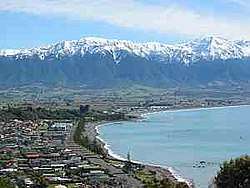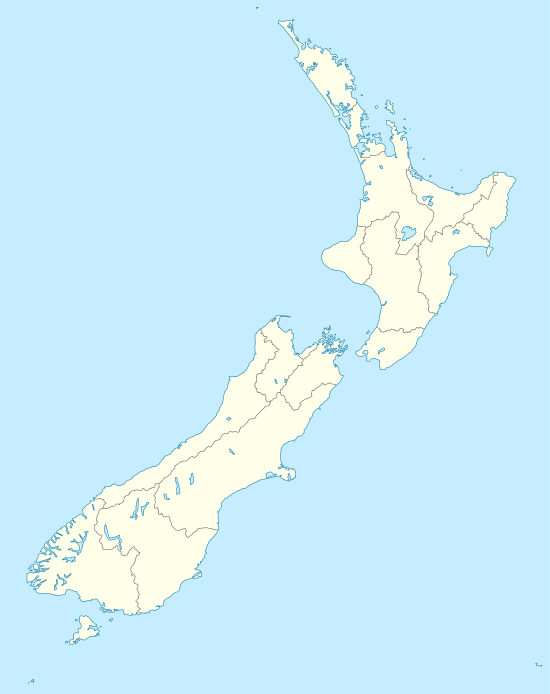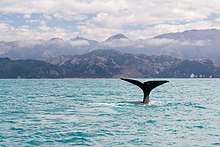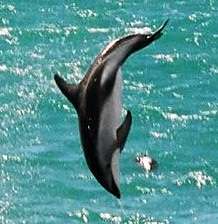Kaikōura
Kaikōura (/kaɪˈkɔːrə/) is a town on the east coast of the South Island of New Zealand. It is located on State Highway 1, 180 km north of Christchurch. The town has an estimated permanent resident population of 2,210 (as of June 2019).[1]
Kaikōura | |
|---|---|
 Town of Kaikoura as seen from the peninsula | |
 Kaikōura | |
| Coordinates: 42.40°S 173.68°E | |
| Country | New Zealand |
| Region | Canterbury |
| Territorial authority | Kaikōura District |
| Government | |
| • Mayor | Craig Mackle |
| • Deputy Mayor | Julie Howden |
| Area | |
| • Urban | 6.78 km2 (2.62 sq mi) |
| • District | 2,046.77 km2 (790.26 sq mi) |
| Population (June 2019)[1] | |
| • Urban | 2,210 |
| • Urban density | 330/km2 (840/sq mi) |
| • District | 4,110 |
| • District density | 2.0/km2 (5.2/sq mi) |
| District Postcode(s) | |
| City Postcode | 7300 |
| Website | www |
The town is the governmental seat of the territorial authority of the Kaikōura District, which is politically a part of the Canterbury region.[2] Kaikōura was the first local authority in the Southern Hemisphere to achieve recognition by the EarthCheck Community Standard.[3]
The infrastructure of Kaikōura was heavily damaged in the 2016 Kaikōura earthquake, which caused two deaths in the area. The bay and surrounding region were uplifted by as much as 2 metres.
History
From 1853 to 1876, Kaikōura was administrated as part of the Nelson Province. In 1876 the Kaikoura County was formed.
On 14 November 2016 a 7.8-magnitude earthquake struck the South Island just after midnight. It left two people dead and triggered a small tsunami. One thousand tourists and hundreds of residents were stranded in Kaikōura after the earthquake cut off train and vehicle access.[4][5]
Geography

The stretch of coastline stretching roughly between the mouths of the Conway and Clarence Rivers is generally known as the Kaikōura Coast. This coast is unusual for the South Island east coast, as there is very little coastal plain, with the Seaward Kaikōura Range, a branch of the Southern Alps, rising straight from the ocean.
The town of Kaikōura itself has a beautiful setting, with the Seaward Kaikōuras as a backdrop. Because of this, there are many walking tracks up and through the mountains. A common one for tourists is the Mt. Fyffe track, which winds up Mt. Fyffe, and gives a panoramic view of the Kaikōura peninsula from the summit.
Mt. Fyffe owes its name to the first European family to settle in Kaikōura, the Fyffe family. The cottage that they lived in, built in 1842, still stands, and is now a tourist attraction operated by Heritage New Zealand. The construction of the cottage is unusual in that the supporting foundations of the house are made of whalebone.[6]
The Kaikōura Peninsula extends into the sea south of the town, and the resulting upwelling currents bring an abundance of marine life from the depths of the nearby Hikurangi Trench. The town owes its origin to this effect, since it developed as a centre for the whaling industry. The name Kaikōura means 'meal of crayfish' (kai – food/meal, kōura – crayfish)[7] and the crayfish industry still plays a role in the economy of the region. However Kaikōura has now become a popular tourist destination, mainly for whale watching (the sperm whale watching is perhaps the best and most developed in the world) and swimming with or near dolphins. There is also a large and readily observed colony of southern fur seals at the eastern edge of the town. At low tide, better viewing of the seals can be had as the ocean gives way to a rocky base which is easily navigable by foot for quite some distance.
It is also one of the best reasonably accessible places in the world to see open ocean seabirds such as albatrosses, petrels and shearwaters, including the Hutton's shearwater which nests high in Kaikōura mountains. A strategic plan for the future of the Kaikoura Coast is being developed by Te Korowai o te Tai o Marokura, the Kaikōura Coastal Guardians.[8][9]
Climate
| Climate data for Kaikōura | |||||||||||||
|---|---|---|---|---|---|---|---|---|---|---|---|---|---|
| Month | Jan | Feb | Mar | Apr | May | Jun | Jul | Aug | Sep | Oct | Nov | Dec | Year |
| Average high °C (°F) | 20.6 (69.1) |
20 (68) |
18.8 (65.8) |
16.6 (61.9) |
14.1 (57.4) |
11.6 (52.9) |
10.9 (51.6) |
11.5 (52.7) |
13.6 (56.5) |
15.3 (59.5) |
16.9 (62.4) |
19.1 (66.4) |
15.7 (60.3) |
| Average low °C (°F) | 12.8 (55.0) |
12.8 (55.0) |
11.9 (53.4) |
9.9 (49.8) |
7.7 (45.9) |
5.8 (42.4) |
5.1 (41.2) |
5.6 (42.1) |
6.7 (44.1) |
8.2 (46.8) |
9.8 (49.6) |
11.7 (53.1) |
9 (48) |
| Average precipitation mm (inches) | 47 (1.9) |
59 (2.3) |
92 (3.6) |
81 (3.2) |
71 (2.8) |
75 (3.0) |
80 (3.1) |
78 (3.1) |
70 (2.8) |
74 (2.9) |
60 (2.4) |
54 (2.1) |
844 (33.2) |
| Source: NIWA Climate Data[10] | |||||||||||||
Demographics
| Year | Pop. | ±% p.a. |
|---|---|---|
| 2006 | 3,621 | — |
| 2013 | 3,552 | −0.27% |
| 2018 | 3,912 | +1.95% |
| Source: [11] | ||
Kaikōura District had a population of 3,912 at the 2018 New Zealand census, an increase of 360 people (10.1%) since the 2013 census, and an increase of 291 people (8.0%) since the 2006 census. There were 1,458 households. There were 1,998 males and 1,911 females, giving a sex ratio of 1.05 males per female. Of the total population, 630 people (16.1%) were aged up to 15 years, 600 (15.3%) were 15 to 29, 1,848 (47.2%) were 30 to 64, and 831 (21.2%) were 65 or older. Figures may not add up to the total due to rounding.
Ethnicities were 86.0% European/Pākehā, 18.4% Māori, 0.8% Pacific peoples, 4.1% Asian, and 2.6% other ethnicities. People may identify with more than one ethnicity.
The percentage of people born overseas was 15.7, compared with 27.1% nationally.
Although some people objected to giving their religion, 49.5% had no religion, 38.9% were Christian, and 4.3% had other religions.
Of those at least 15 years old, 417 (12.7%) people had a bachelor or higher degree, and 738 (22.5%) people had no formal qualifications. The median income was $32,400. The employment status of those at least 15 was that 1,806 (55.0%) people were employed full-time, 564 (17.2%) were part-time, and 39 (1.2%) were unemployed.[11]
Economy
At the 2013 census, the largest employment industries in the Kaikōura District were accommodation and food services (19.5%), agriculture, forestry and fishing (17.7%) and retail trade (11.5%).[12]
Culture
Takahanga Marae, a marae (tribal meeting ground) of Ngāi Tahu and its Te Rūnanga o Kaikōura branch, is located in Kaikōura. It includes the Maru Kaitatea wharenui (meeting house).[13][14]
Government
Local governance history
At a provincial level, the area of Kaikōura initially belonged to the Nelson Province. When the Marlborough Province split off from the Nelson Province, Kaikōura became part of that new province, with the Conway River the new southern boundary. Provincial government was abolished at the end of 1876, and counties were formed instead.[15]
Kaikōura was from 1877 governed by Kaikoura County.[16] The county's boundary was adjusted northwards in 1940 to take over most of the East Coast Riding of Awatere County. There were also desires for land from Cheviot County to transfer to Kaikoura County, but the petition lapsed. In 1952, there were moves for a borough to be formed for Kaikōura township, but the underlying concerns from which the initiative resulted were addressed in different ways and no borough was formed. A 1971 scheme to form a Hurunui County would have seen Kaikoura County lose the area south of the Hundalee Hills, but this did not proceed.[17]
The 1989 local government reforms disestablished all counties, and district and regional councils were formed instead. Kaikōura District was formed in the process, with the land south of the Hundalee Hills transferred to Hurunui District as per the 1971 proposal. At a regional level, Kaikōura belonged to the Nelson-Marlborough Regional Council. When the regional council was disestablished in 1992 after only three years and its functions went to the unitary authorities of Nelson City Council, Tasman District Council, and Marlborough District Council, Kaikōura transferred to the Canterbury Regional Council. In 1993, an elector-initiated appeal wanted the northern 59% of Kaikōura District to be transferred to Marlborough District, but this was rejected by the Local Government Commission. There was a further elector-initiated proposal for Kaikoura District to merge with Hurunui District, but the Local Government Commission rejected this in 2009.[17]
In terms of its provincial anniversary holiday, Kaikōura observes the anniversary of Marlborough Province due to its historic association. This meant that the public holiday established through the Canterbury Earthquake Commemoration Day Act 2011 did not apply in Kaikōura District as it only applied to the area where the Canterbury Anniversary Day is observed.[18]
Kaikōura District
Kaikōura District has a land area of 2,046.41 km² (790.12 sq mi) and an estimated population of inhabitants; which includes other populated places within the district (aside from Kaikōura):
Provincial representation
The town of Kaikōura was represented through an elected representative of the Amuri electorate on the Nelson Provincial Council. From 1860, the area was represented on the Marlborough Provincial Council first through the Flaxbourne and Clarence electorate, then the Clarence electorate, and finally the Awatere electorate.[16]
Transport

The town is on State Highway 1 and the northern section of the South Island Main Trunk Railway. Kaikōura also has a small sealed airstrip located 6 km south of the main centre. Kaikoura Airport is mainly used for whale spotting tourist flights but it can also be used by small private and charter flights. It previously had return flights to Wellington operated by Sounds Air.
Rail
Kaikōura is served by the Main North Line, the northern section of the South Island Main Trunk Railway. The line opened north of Kaikōura on 13 March 1944, while the line south of the town opened on 15 December 1945, the latter completing the full line Christchurch to Picton.[19]
Kaikōura is served by the Coastal Pacific long-distance passenger train, formerly called the TranzCoastal, which connects the town with Christchurch to the south, Picton and the Cook Strait ferries to the north. Kaikoura Station was the last station in New Zealand to have a refreshment room for passengers, which closed in 1988 when the Coastal Pacific Express (former name for the TranzCoastal) introduced on-board refreshments.
Freight trains also pass through the town, mainly carrying freight between the marshalling yards at Middleton in Christchurch and the Interislander rail ferries at Picton.
The Main North Line (Picton to Christchurch, passing through Kaikōura) suffered damage in the November 2016 earthquake and was closed for repairs, re-opening to freight traffic on 15 September 2017. The Coastal Pacific is expected to resume running once all repairs are completed in mid 2018.[20]
Education
Media
Newspapers
The main newspapers for Kaikōura are the Wednesday weekly Kaikoura Star and Monday to Friday late morning daily The Marlborough Express. The early morning Monday-Saturday Christchurch based daily The Press is also available. These papers are all owned by Fairfax New Zealand
Radio
Kaikōura has three locally transmitted radio stations on FM. These are More FM Marlborough (formerly Sounds FM) broadcast from Blenheim during the day and Auckland at night, Blue FM which is a locally broadcast Kaikōura station, and Tahu FM broadcast from Christchurch. Non local transmissions of the following stations can be received: The Breeze (Wellington AM/FM), Radio New Zealand National (Wellington AM/FM), ZM (Wellington and Christchurch FM), Radio Hauraki (Christchurch).
Entertainment
Movies are shown at the Mayfair cinema (opened 1935), located on the Esplanade, and historically known for its carbon arc movie projector. In November 2013 the cinema went digital. Due to earthquake, it has closed.[21]
Gallery
 Seaward Kaikoura Range from Kaikoura town
Seaward Kaikoura Range from Kaikoura town The Seaward Kaikoura mountain range from Kaikoura
The Seaward Kaikoura mountain range from Kaikoura View of a beach and Seaward Kaikoura Range from Kaikoura
View of a beach and Seaward Kaikoura Range from Kaikoura Fyffe House
Fyffe House Whale watching vessel
Whale watching vessel- A sperm whale seen from on a whale-watching tour boat off Kaikoura
- A seal colony on Kaikoura's peninsula
 A fur seal on the beach at Kaikoura
A fur seal on the beach at Kaikoura
References
- "Subnational Population Estimates: At 30 June 2019". Statistics New Zealand. 22 October 2019. Retrieved 11 January 2020.
- "Archived copy" (PDF). Archived from the original (PDF) on 8 February 2013. Retrieved 12 December 2012.CS1 maint: archived copy as title (link)
- "Green Globe". Kaikoura District Council. Archived from the original on 21 March 2008. Retrieved 14 March 2008.
- "Hundreds of tourists stranded by New Zealand quake rescued by helicopter – World – CBC News". Cbc.ca. Retrieved 29 March 2017.
- "Live updates following Monday's 7.8 earthquake: A picture of devastation". New Zealand Herald. 16 November 2016. ISSN 1170-0777. Retrieved 17 November 2016.
- "Fyffe House at the New Zealand Historic Places Trust". Archived from the original on 1 April 2008. Retrieved 18 May 2008.
- "1000 Māori place names". New Zealand Ministry for Culture and Heritage. 6 August 2019.
- Kaikoura Coastal Marine Values and Uses A Characterisation Report. Te Korowai o Te Tai o Marokura (Kaikoura Coastal Marine Guardians). Second edition May 2008.
- "Team Korowai – Te Korowai o Te Tai o Marokura – Kaikoura Coastal Guardians". Fishnet.co.nz. Retrieved 16 October 2012.
- "Climate Data". NIWA. May 2011. Retrieved 2 November 2007.
- "Statistical area 1 dataset for 2018 Census". Statistics New Zealand. March 2020. Kaikoura District (054). 2018 Census place summary: Kaikōura District
- "2013 Census QuickStats about work and unpaid activities". Statistics New Zealand. 31 March 2015. Retrieved 20 May 2017.
- "Te Kāhui Māngai directory". tkm.govt.nz. Te Puni Kōkiri.
- "Māori Maps". maorimaps.com. Te Potiki National Trust.
- McLintock, Alexander Hare, ed. (1966). Nelson Province and Provincial District. An Encyclopaedia of New Zealand. Retrieved 20 November 2017.
- Sherrard, J. M. (1966). Kaikoura: A History of the District. Kaikoura County Council.
- "Determination on proposal for the abolition of Kaikoura District and its inclusion in Hurunui District" (PDF). Local Government Commission. May 2009. Retrieved 20 November 2017.
- "Kaikoura not taking day off". The Marlborough Express. 16 March 2011. Retrieved 27 June 2017.
- "Geographical Mileage Table 1957" (PDF). New Zealand Railways. Retrieved 19 November 2016.
- "Coastal Pacific". Retrieved 30 September 2017.
- "Big plans afoot for Kaikoura's earthquake-damaged Mayfair Theatre". Stuff. Retrieved 30 September 2017.
External links
| Wikimedia Commons has media related to Kaikōura. |
| Wikivoyage has a travel guide for Kaikōura. |